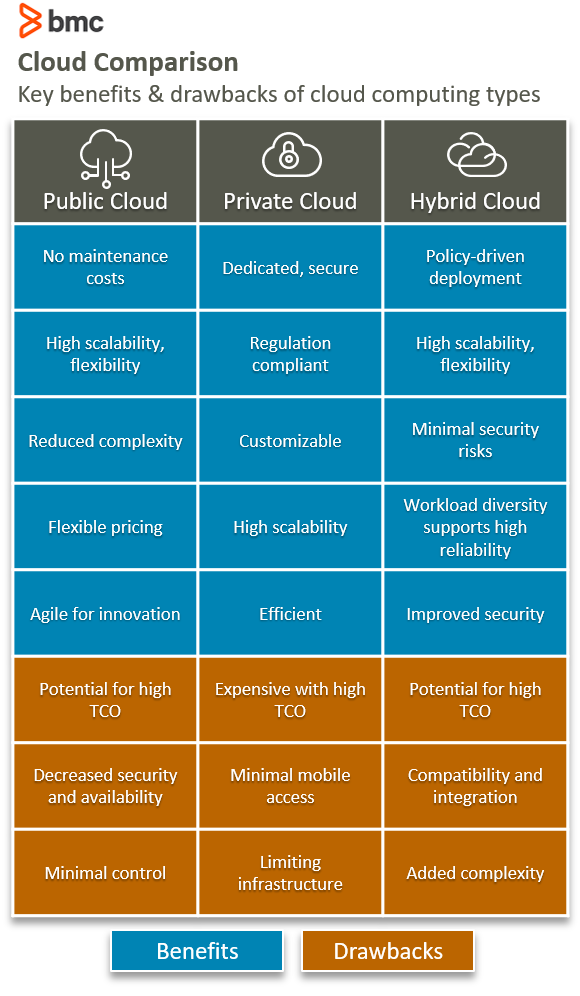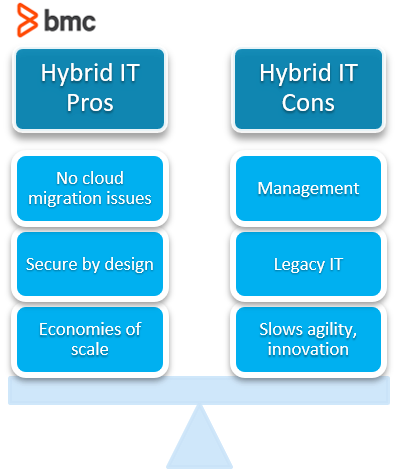In this article, we’ll look at two terms that have a lot in common but aren’t the same: hybrid IT and hybrid cloud. We’ll look at:
Hybrid cloud
When cloud computing replaced traditional datacenter models as the preferred choice among small and midsize (SMB) firms, IT was challenged to migrate workloads to the cloud. From a business perspective, cloud migration is a strategic and tactical imperative for SMB organizations.
Cloud computing allows organizations to take advantage of a vast pool of resources offered on an operational expense basis. The model allows organizations to opt for public cloud resources for workloads that are more resource-intensive but less sensitive to security concerns and privacy regulations. Alternatively, they can use private cloud deployments to operate private data centers resources accessible over the Internet for superior security performance at a higher cost.
With Hybrid Cloud computing technologies, organizations can take advantage of both private and public cloud systems, achieving an optimal tradeoff between cost, security, and performance. Hybrid cloud computing can be defined as:
A mix of computing resources orchestrated and delivered as a service from public and private cloud environments over the Internet.

Hybrid IT
However, legacy software systems on in-house data center technologies cannot always migrate to the cloud without presenting an overwhelming technical and financial challenge. In such a case, organizations can run a mix of traditional IT systems, along with a variety of cloud computing deployments. Both systems are collectively managed for:
- Resource provisioning
- Scaling
- Cost
- Security
- Related aspects
Such a system of resources is referred to as Hybrid IT, and it takes care of issues such as security, compliance, interdependencies with legacy systems, and cost of workload migration, among others.
Hybrid IT blends cloud architecture flavors—public, private, hybrid—with in-house data centers in order to deliver data workloads, apps, and services across the hybrid infrastructure environments.

Hybrid cloud vs hybrid IT: Advantages of each
Let’s explore the comparable advantages of Hybrid IT and Hybrid Cloud in detail.
Advantages of Hybrid IT infrastructures
- Legacy systems can coexist, especially when modernizing legacy IT is challenging.
- Evolving IT environments can evolve gradually instead of having to adopt disruptive cloud migration projects across the organization.
- Higher value for money, especially when the total cost of cloud ownership (cloud TCO) may be significantly higher in comparison with on-site data center technologies.
- Safe and secure IT model for operating mission-critical and sensitive workloads on-premise.
Advantages of Hybrid Cloud environments
- Flexible, policy driven deployment. Workloads can be moved across public and private cloud resources per changing organizational policy on security, cost, and other key decision criteria.
- Balancing public and private cloud options gives you the optimal tradeoff between cost, security, and performance.
- Workload diversity supports high reliability. Workloads sensitive to uptime performance can be moved to dedicated private cloud resources. Less sensitive workloads can continue to run on cheaper public cloud deployments.
Hybrid cloud vs IT: Limitations of each
Both the Hybrid IT infrastructure and Hybrid Cloud environments have their limitations. Some of the comparable limitations include:
Limitations of Hybrid IT
- Legacy IT persists, eventually running into software delivery performance bottleneck.
- Hybrid IT requires additional resources internally to manage information security, access controls, backups, updates, and configurations on in-house data center environments.
- Traditional IT moves slowly, and the overall pace of innovation may be determined by the performance and improvements in software running on in-house data centers that cannot migrate to the cloud.
- Optimizing Hybrid IT for security and performance is a challenge without the right resources and talent on-board.
Limitations of Hybrid Cloud
- Managing costs of hybrid cloud are significantly higher than public cloud environments. These also require organizations to follow a strict shared responsibility model with multiple vendors.
- Cloud skills shortage means that many SMB firms cannot take full advantage of their cloud migration initiatives.
- Existing applications must be modernized to work optimally in the hybrid cloud environment. This may require additional investments and updates to legacy software systems.
Thoughts on extending to Multi-Cloud
In practice, the concept of Hybrid Cloud is further extended to multiple cloud services, collectively running a mix of private and public cloud deployments across multiple service vendors. The environments are managed collectively, and workloads can transition across the environments based on required resources, service offerings, functionality, and cost performance, among other key factors.
While the portability and variety of options are made available with a multi-cloud or hybrid IT environment, the challenge for IT is to ensure how the siloed services and infrastructure resources can interact across silos or manage interdependencies. It is therefore important to address the following considerations when choosing between Hybrid IT, Hybrid Cloud ,and other hybrid mix IT infrastructure and service delivery models:
- Seamless workflow management across IT environments is critical.
- Interdependency issues for legacy apps and lack of standardization between different cloud vendors can cause reliability issues and reduce cost performance of hybrid IT or hybrid cloud projects.
- Future-proof your IT investments, without investing in cloud computing prematurely. Successful cloud migration requires more than just subscriptions to new cloud services. It requires accurate understanding of your current and future technology and business needs; modernization of legacy apps; tooling; and the talent to manage it all.
- Vendor lock-in prevents convenient and cost-effective switching between cloud vendors. Many service providers make it easy to subscribe and migrate data and workloads, while making it difficult and expensive to migrate the resources later.
- Shadow IT is a threat for successful cloud projects. Especially with Hybrid-IT environments, cloud services subscribed with a shadow-IT practice interacting with legacy apps can quickly lead to security and dependency issues.
- Strong governance and organizational controls are required to ensure that configuration changes and infrastructure management do not cause unwarranted security or performance disruptions to mission-critical apps running on legacy systems in-house.
Additional resources
For more on this topic, check out the BMC Multi-Cloud Blog and these articles:
- State of the Cloud in 2020
- Cloud Growth in 2020: Trends & Outlook
- How to Secure Your Public Cloud
- Rise of Data Centers and Private Clouds in Response to Amazon’s Hegemony
- BMC’s Cloud Approach Combines Private and Public Cloud to Maximize Value
- How to Reduce Risks of Shadow IT by Applying Governance to Public Clouds
These postings are my own and do not necessarily represent BMC's position, strategies, or opinion.
See an error or have a suggestion? Please let us know by emailing blogs@bmc.com.






